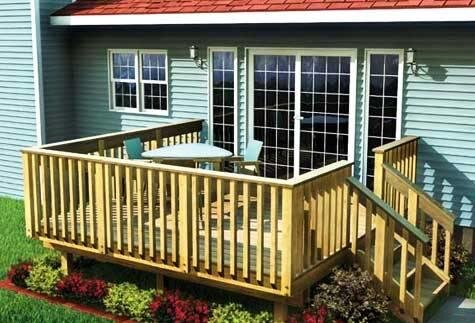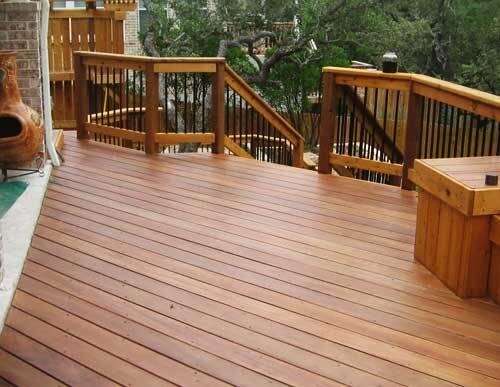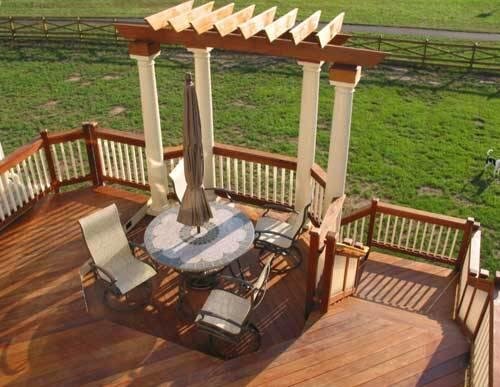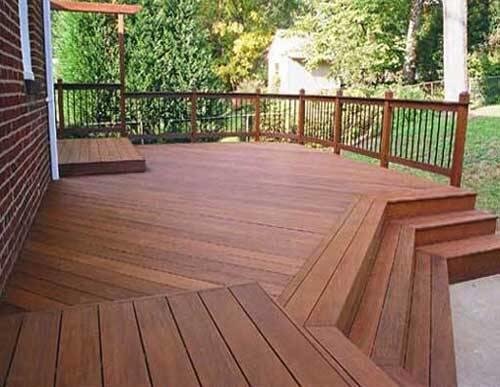
Wood Decks
Wooden Decking
Wood is by far, the most popular choice of deck materials in the U.S. This is because it is long-lasting and the most economical. About 80% of pressure treated wood is Southern yellow pine, although other plentiful local species are used in some areas.
Grain patterns are prominent; its initial greenish color becomes a honey brown before fading to gray. It is available in nearly every lumber outlet in various grades and in common lumber dimensions plus 5/4 (spoken five-quarter) decking profiles. Tags stapled on the ends of lumber indicate the intended use, e.g., above ground or ground contact. Some dealers carry material that contains built-in water repellent or is re-dried after treatment.
The chemical preservative is forced into the wood cells under pressure. Pressure treated wood usually has a warranty against decay and termite damage, in most cases for the lifetime of the original purchaser. Preserved lumber is also used for fencing, landscaping, walkways, and other backyard projects.
Pressure Treated
Pressure-treated wood is truly a "wood for all seasons". Yet, there is much misinformation, and, in some cases, disinformation concerning pressure-treated wood, its maintenance requirements, and its safety in common use. Let's explore the story of pressure-treated wood, and together seek out the truth.
What is pressure-treated wood?
Over 70 years ago, Dr. Karl Wolman invented the process of infusing preservative deeply into wood products. Today, a giant industry has grown up around his quest to invent a wood that can last forever.
Pressure treating is a process that forces a chemical preservative deep into the wood. The wood product is placed into a humongous cylindrical holding tank, and the tank is depressurized to remove all air. The tank is then filled with the preservative under high pressure, forcing it deeply into the wood. The tank is then drained and the remaining preservative reused. The wood is removed from the tank and prepared for shipment to your local lumberyard.
Needless to say, this process makes the wood quite unappetizing to all vermin, insects, and fungus, which accounts for its 20 year plus lifespan under the harshest conditions!
Hardwood Decks
Why choose Hardwood Decking?
Hardwood decking has become very popular. These decking materials are imported from other countries, primarily from South America.
Hardwoods like cumaru, garapa, jatoba, massaranduba and tigerwood offer beauty, durability and strength no other decking options can match.
Ipe, cumaru and the other hardwoods are easier to mill and install than many other deck options. Choose from a variety of colors, ipe, garapa, massaranduba and other species allow home owners and contractors to choose the hardwood decking that best fits their plans.
Go Natural!
Brazilian hard wood and other hard wood decking choices provide exactly what you need to go with your well-planned home.
Hardwoods have a beautiful, dark rich looking appearance, having much the same look as woods typically used for interior work. They are virtually clear of knots, very dense, and extremely resistant to rot and decay.
IPE Decks
IPE wood is commonly referred to as one of one of the hardest woods known to man. IPE will outlast most all other decking products on the market. Its sleek appearance is arguably one of the most attractive decking around.
IPE (aka. Ironwood) is one of many commercial names used for the the imposing Lapacho group of trees from the various species of Tabebuia. The trees generally grow from 140 to 150 feet, but some can reach heights of 200 feet. Some other common names for the trees from this group include Bethbara and Lapacho, and a host of names used in the countries where the trees grow. The trees are mostly found in Brazil as well as throughout Central and South America and some of the Lesser Antilles.
IPE'S strong, tough resilient properties make it an excellent material and increasingly popular choice for commercial/residential decking and outdoor furniture. It is prized for its stability, durability, strength and natural resistance to decay, wet conditions, and infestation by termites and borers. It is available in long lengths and relatively easy to season. Ipe has a Class A fire rating, the same rating given to concrete and steel.
Why should you build your deck with IPE Decking?
IPE has benefits that make it the world's premier decking material. With genuine beauty and durability, your IPE deck will stand up to harsh climates and resist problems such as insect damage, mold, & decay. Is it any wonder why architects and designers across the world feature IPE wood in many high-end homes and applications?







